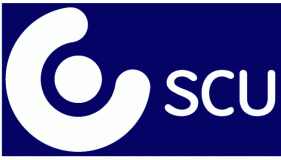Category Archives: Faculty of Health and Applied Sciences
The Faculty of Health and Applied Sciences brings together experts from Allied Health Professions, Applied Sciences, Health and Social Science, and Nursing and Midwifery.
Welcoming Hannah Little, new lecturer in the Science Communication Unit
My name is Hannah Little. I’m a new lecturer at the Science Communication Unit. I will be teaching Science Communication at foundation, undergraduate and postgraduate levels, specially focussing on areas in digital communication.
Previously, I have worked professionally in science communication, primarily coordinating the STEM Ambassador and Nuffield Research Placement programmes in the North East of England. I have come to the Science Communication Unit after completing a PhD at the Artificial Intelligence Lab at the VUB in Belgium, and a PostDoc at the Max Planck Institute for Psycholinguistics. My work throughout both my PhD and PostDoc was primarily on the evolution of linguistic structure. One method I have used in my research is cultural transmission experiments in the lab.
These experiments investigate how language (or any behaviour) is changed as a result of being passed from one mind to another in a process similar to the game “Telephone”. One person’s output becomes the input for a new person, whose output is fed to a new person and so on! This method is being used more and more to look at processes of cultural evolution, and I am interested in using these methods to investigate processes in science communication.

Norman Rockwell (1894-1978), “The Gossips,” 1948. Painting for “The Saturday Evening Post” cover, March 6, 1948.
I see existing work in cultural evolution fitting into science communication in 3 main areas:
Science Writing
Using experiments to investigate how stories and information are culturally transmitted isn’t new. As far back as 1932, Bartlett’s book “Remembering” describes experiments that looked at how transmission of a memory from one person to another can affect what information persists, and what is forgotten through a failure in the transmission process. More recently, Mesoudi et al. (2006) used similar experiments to systematically investigate whether information is transmitted more faithfully when it is embedded in a narrative around social interactions compared to equivalent non-social information. I am keen to explore these findings in practical contexts in science communication, for instance looking at how well information persists from scientific article to press release to media story as a result of different types of content in a press release.
Digital Communication
The internet is the home of the “meme” a culturally transmitted idea (this could be any idea, picture, video, gif or hashtag). New methods from big data analysis are being used by scholars interested in cultural evolution to explore the proliferation of memes, and this is even starting to happen in science communication too. Veltri & Atanasova (2015) used a database of over 60,000 tweets to investigate the main sources of information about climate change that were proliferated on twitter and the content of tweets that were most likely to be retweeted. They found that tweets and text with emotional content was shared more often. These findings fit with the findings from Mesoudi et al. (2006) above, demonstrating that multiple sources and methods can be used to accumulate evidence on what it is that allows scientific information to be a) transmitted in the first place, and b) transmitted faithfully.
Hands-on science activities
Another hot topic in cultural transmission is the role of innovation and creativity in the transmission of information resulting in an accumulation of information. Caldwell and Millen (2008) investigated this process using an experiment whereby participants were asked to build the tallest tower possible using just dried spaghetti and blue tack, or the paper aeroplane that flew the furthest. Participants were able to see the attempts of people who had gone before, giving them the option to copy a design that had already been tried, or innovate a new design. The study found that participants got better at building successful towers and aeroplanes later in transmission chains than earlier, indicating that successful engineering skills were being acquired just from the process of cultural transmission. This, of course, is a brilliant finding in its own right, but there is a huge amount of scope for using this paradigm to investigate what affects cumulative cultural evolution in the context of issues relevant to science communication. For example, does explicit learning or simple imitation affect rates of innovation and success? This question has previously been explored using cooking skills in Bietti et al. (2017) and paper aeroplanes in Caldwell & Millen (2009). You can also use these methods to investigate questions about whether the characteristics of the person transmitting the information plays a role in faithful transmission or innovation (e.g. their gender, age, perceived authority, etc.).
Together, I think these case studies of existing literature outline the scope of methods and insight available from the field of cultural evolution to questions in science communication, and I look forward to working with the unit at UWE to generate some new research in these areas!
Hannah Little
References
Bartlett, F. C. (1932). Remembering. Cambridge: Cambridge University Press.
Caldwell, C. A., & Millen, A. E. (2008). Experimental models for testing hypotheses about cumulative cultural evolution. Evolution and Human Behavior, 29(3), 165-171.
Veltri, G. A., & Atanasova, D. (2015). Climate change on Twitter: Content, media ecology and information sharing behaviour. Public Understanding of Science, 0963662515613702.
Postgraduate Science Communication students get stuck in on ‘Science in Public Spaces’
Emma Weitkamp & Erik Stengler
September saw the lecturing staff at the Science Communication Unit welcoming our new MSc Science Communication and PgCert Practical Science Communication students to UWE and Bristol. It also sees the start of our refreshed programme offering, which includes significant changes and updates to two of our optional modules: Science in Public Spaces and Science on Air and On Screen.
The first three-day block of Science in Public Spaces (SiPS) marks the start of a diverse syllabus that seeks to draw together themes around face-to-face communication, whether that takes place in a what we might think of as traditional science communication spaces: museums, science centres and festivals or less conventional spaces, such as science comedy, theatre or guided trails. Teaching is pretty intense, so from Thursday, 29th September to Saturday, 1st October, students got stuck into topics ranging from the role of experiments and gadgets to inclusion and diversity.
Practical science fair
Thursday, 29th September saw the 13 SiPS students matched with researchers from the Faculty of Health and Applied Sciences. Students were introduced to cutting edge research and have been challenged to think about how this could be communicated to the public in a science fair setting. Each student will work with their researcher to create a hands-on activity which they will have the opportunity to deliver to the public at a science fair to be held during a University Open Day in the spring.
Towards the end of the three days a session on creativity generated intense discussion about how we might judge what creativity is through to practical techniques and tips we might use to stimulate creative thinking. The session included a word diamond (McFadzean, 2000), where groups considered how you might foster engagement and enjoyment amongst blind visitors to the Grand Canyon, how blind visitors could be involved in creating a sensory trail (for sighted people) at an arboretum or how to enable a local community to be involved in decision making around land use that involved ecosystem services trade-offs. Challenging topics that draw on learning from earlier in the week.
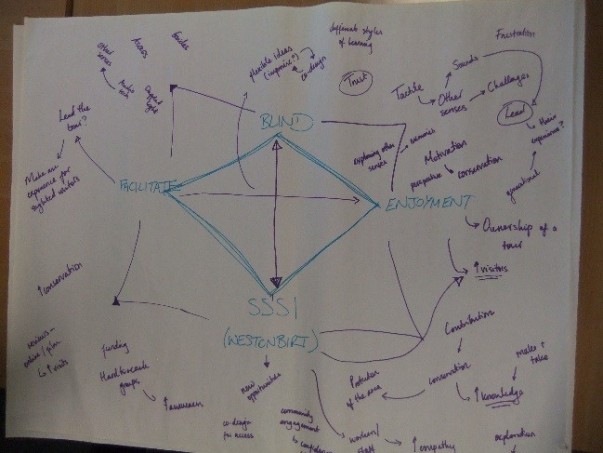
After a final session on connecting with audiences, students (and staff) were looking a little tired; three days of lectures, seminars and workshops is exhausting. We hope students left feeling challenged, excited and ready to start exploring this new world of science communication and public engagement and that they find ways to connect their studies with events and activities they enjoy in their leisure time – though that might not apply to the seminar reading!
Science in Public Spaces got off to an excellent start, thanks to the students for their engaged and thoughtful contributions in class. Up next is the Writing Science module, where Andy Ridgway, Emma Weitkamp and a host of visiting specialists will be introducing students to a wide range of journalistic techniques and theories. Then it will be the turn of the new Science on Air and on Screen where Malcolm Love will introduce students to techniques for broadcasting science whether on radio, TV or through the range of digital platforms now open to science communicators. Looks to be an exciting year!
McFadzean, E. (2000) Techniques to enhance creativity. Team Performance Management: An International Journal, 6 (3/4) pp. 62 – 72
Baby-led, puree, Annabel Karmel and me? When science impacts on the choices we make in parenting
How we make choices as consumers, patients, parents and members of the public has, of course, long been of interest to science communicators, and topics like immunisation can continue to raise differences in perspectives, as well as media interest. A few years ago we started to think about the sometimes challenging process of weaning a baby. Ruth had recently had two young children herself, whilst completing her MSc Science Communication with us, and I’d been doing some research with parents and caregivers in community groups, so we knew weaning was a topic that was being discussed. But what about the parents who might not be out there in these social spaces, what was happening online? We asked the question ‘how do people on Mumsnet frame media coverage of weaning?’
As our starting point we considered a review of scientific evidence published in the British Medical Journal in 2011. This work, by Fewtrell and colleagues, suggested the period of exclusive breastfeeding recommended by the World Health Organisation be reduced from six months to four. Unsurprisingly the study attracted media attention, particularly in ‘quality’ newspapers like The Times, The Guardian, and especially, The Telegraph, and was frequently reported on by specialist health and science correspondents. They tended to talk about ‘risk’ but rarely contextualised that with further information on the study itself.
On Mumsnet it was clear that a vibrant community was keen to discuss the issue of weaning, and we located 112 comments that directly referred to the Fewtrell example and its media coverage. What were people most wanting to talk about? The inaccuracy of media coverage really stood out in their comments, as well as frustration that it was returning to the breast vs. bottle aspects of the debate. And the forum discussions often presented more context, nuances around the question of ‘risk’ and the details of the study itself. Of course, they had more room to do so, but it was interesting to see these types of details being discussed.
What does this tell us about science, the media and how it’s discussed online? Well it suggests that at least amongst this very small sample of Mumsnet users there is some awareness of the weaknesses that can be present in science and health reporting, but also that people often use scientific and personal information in transitionary means, embellishing some of the deficiencies of media coverage in interesting and new ways. As people become more and more reliant on social media sources for information, further work is needed on how this is supplementing and challenging our relationships with scientific and medical expertise but also how we use our social networks to support decision making. You can find out more about this work in a recent Journalism article or at:
http://eprints.uwe.ac.uk/27843/3/The_Worries_of_Weaning_paper_10_10_15%20-%20Copy.pdf
Clare Wilkinson and Ruth Knowles
What happens to sci comms graduates?
Lots of people are interested to find out what our Masters in Science Communication and Postgraduate Certificate in Practical Science Communication students at UWE, Bristol get up to when they leave us. As the infographic shows, it’s pretty impressive. We’re currently advertising part-bursaries to study with us in 2016/17, if you’d like more info contact Clare.Wilkinson@uwe.ac.uk
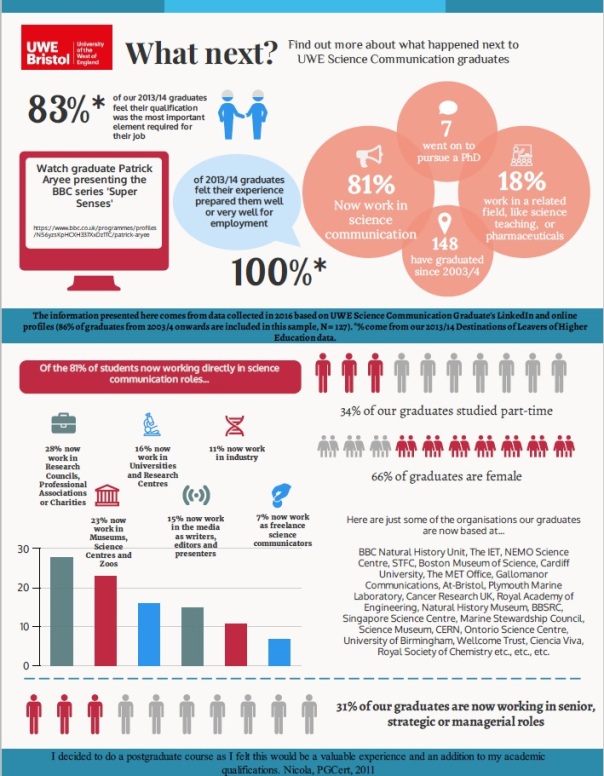
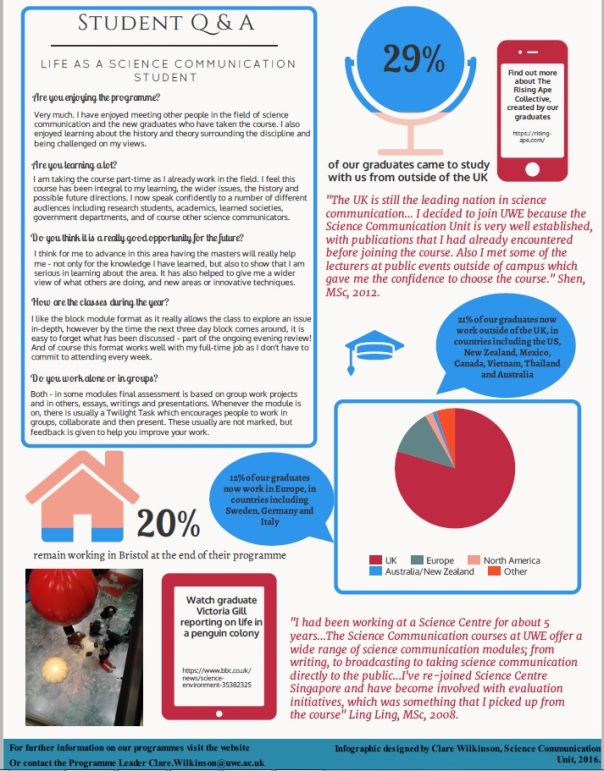
You can download a pdf of this infographic: Sci Comm UWE Graduate Destination Infographic 2016
Clare Wilkinson, the programme leader, will be presenting some of this information at next week’s PCST Annual Conference.
Science Writing Competition now open
It’s been a busy few weeks in the office getting ready for the UWE Bristol SCU Science Writing Competition 2016. We are looking for 700 words on “the next big thing in science”.
Entrants can be residents anywhere in the world, but must be non-professionals (professional journalists and anyone else who writes for money). All others, including scientists and bloggers, are welcome to apply. There are no residency restrictions, and we have separate categories for under 18s and over 18s. Closing date for applications is 24th June 2016. For full details, please see the SCU website.
We’re excited to have an impressive judging panel on board, who’ve prepared some excellent tips for new science writers. Fascinating stuff for newbies and old-timers alike.
The competition is run by UWE Bristol’s Science Communication Unit (SCU) in partnership with BBC Focus magazine and the Royal Institution.
Masters and beyond with the SCU
Clare Wilkinson explains some of the programmes that UWE Bristol offers in Science Communication, and how coming back to school builds towards the ‘university of life.’
This year we had around 25 new students joining us to start our MSc Science Communication programme and Postgraduate Certificate in Practical Science Communication.
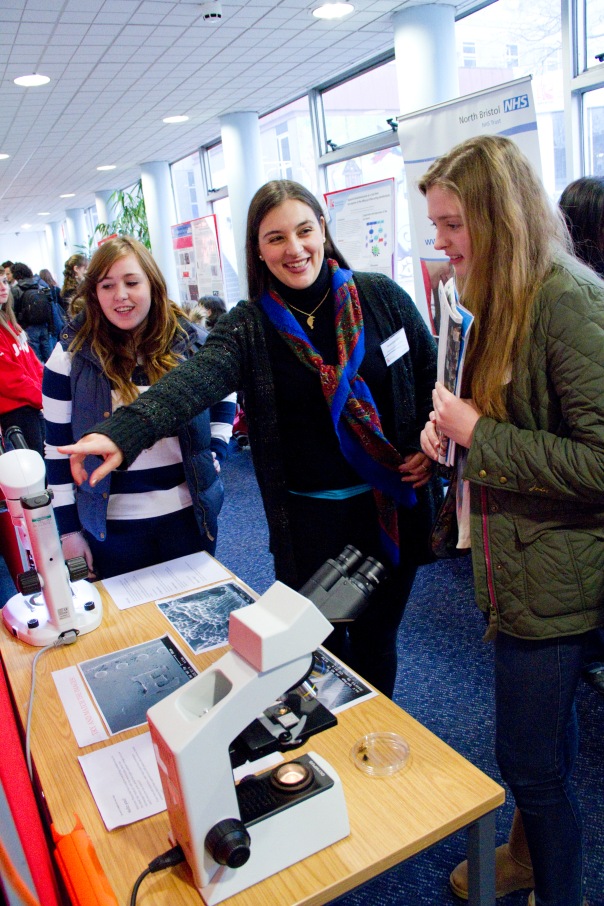
MSc student discusses a project during a UWE open day
At postgraduate level we work with students in a number of ways. Most students join our MSc Science Communication programme, as either a full or part-time student. Running for over ten years this programme has developed an excellent reputation for its combination of theory and practice. This means it continues to attract both those who have just completed a university degree and have already made the decision that their future lies in science communication, as well as students who have been working in a related field for a while and either are looking to make a career transition or to firmly establish a more formal qualification.
Running for over ten years this programme has developed an excellent reputation for its combination of theory and practice.
We also have a smaller number of students who take our Postgraduate Certificate in Practical Science Communication. Typically students on this programme tend to be practicing researchers who have been communicating their own research alongside their ‘day job’ and are looking to develop that experience further. On similar lines we also have a number of PhD students, from a wide range of areas at UWE, who are taking one or two of our science communication modules as part of their PhD programme. It’s fantastic to see early career researchers identifying a role for communication and engagement and building this into their research from the outset.
I tend to think about the programme in three ways; as ‘back to school’, the ‘light bulb’ moment and the ‘university of life’.
Back to school
As programme leader I tend to be in touch with our new students a lot, even before they start their courses. I’ll be confirming people’s module choices, double checking they are on the right programme and often having last minute meetings to let new students, and sometimes their families, get a feel for our campus and team.
Deciding to undertake postgraduate study is a big commitment, intellectually but also from a time and financial perspective, and so it’s understandable that often our students, their partners and families can feel a little nervous about it. I vividly remember once having to explain the potential job prospects of our course to an applicant’s father. Science communication was new to him and he wanted to be 100% sure it would offer his science graduate son a potential route to his desired employment in the future. I’m also well practiced in finding the odd coloured pen or piece of paper for a restless five-year old accompanying their parent to a UWE open evening, with very little interest in the new MSc their caregiver is about to undertake.
Any fearfulness will turn to smiles. A realisation takes hold that they have found a place where everyone shares their interests.
So, whatever the age, circumstances or commitments of our new students, starting a postgraduate programme will often mean change, uncertainty and challenges. My aim is that by the first day all new students feel confident that they have made the right decision for them, so that the ‘back to school’ feeling is one they (and their families) can embrace.
The light bulb moment
The start of the programme is always really busy, and this year was no different. Amongst registration activities, introductions to the library and the practicalities of life as a UWE student we also try to fit in content about life as a science communicator, and importantly, lots of opportunities for our students to meet and talk with each other. You only need to look around the room on the first day to realise that people are feeling nervous, anticipating what they will have in common with their new peers and eyeing up those they might potentially be friends with. This brings me to the light bulb moment.
We get introductions happening straight away… ‘Tell us about yourself’, I will say to each person, ‘just some snippets about you, where you are from and why you are here’. It’s then that it starts, each person around the room expressing their passion for communicating, that they love their subject (whatever that might be – we don’t only accept only science-based students on our programme), but that they think their real strengths lie in engaging around it. And one after another, any fearfulness will turn to smiles. A realisation takes hold that they have found a place where everyone shares their interest in communicating and that this will be their home for the coming weeks, months or years.
The university of life
On the first day, we distribute module guides and assessment information, talk about the various disciplines that influence science communication, and outline the expected level of reading. It will become clear that no student can learn all that there is to know about science communication in the first days or weeks of teaching and that much, much more is to come. As one door has closed on their undergraduate studies, the possibilities at Masters level can seem endless. It can be overwhelming, but as with the start of any new project the possibilities are exciting.
If you are interested in finding out more about the UWE Bristol Science Communication Masters or Postgraduate Certificate, please go to our website.
Welcome to the Science Communication Unit Blog
Hello new readers and welcome to the first post of the Science Communication Unit Blog. If you don’t know much about us we are a team of staff based at the University of the West of England, Bristol who work in science communication practice, teaching and research. We comprise PhD students, science writers and editors, researchers and academics, who come from a variety of academic perspectives to consider the theory and practice of science communication. You can visit our website to find out more about us.
In recent years our team has expanded considerably and so now seemed a good time to launch a blog dedicated to the Unit to help us, and you, to keep up-to-date on our latest happenings. On this blog we will be regularly posting our thoughts and ideas on a range of subjects associated to science communication. This will include updates on our current projects, reflections on science communication theories and ideas, our responses and thoughts on current issues facing the sector, as well as some occasional image and video-based content. We will be posting content every two to three weeks and whilst a lot of the material will be drawn from research evidence and academic materials, we will also use this as a space to occasionally share our personal views.
Does this sound like a good idea? Are there other subjects you’d like to see covered on the blog? Don’t forget you can also use the blog as a space to interact with us, sharing your views and ideas on the subjects we post around.
Clare Wilkinson, Associate Professor in Science Communication.













